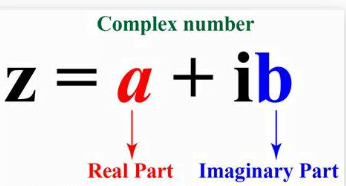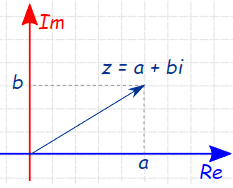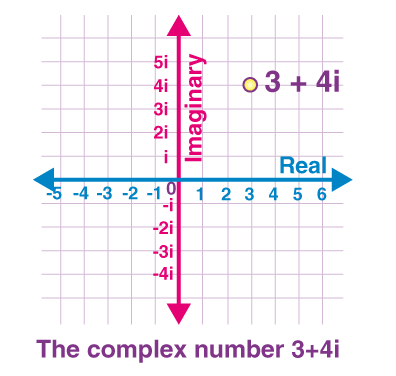5.2 Complex Numbers
Any number of the form \(a+i b\), where \(a\) and \(b\) are real numbers, is defined to be a complex number. We often use Z for a complex number.

In the above complex number equation, z becomes:
- Purely real if b =0; therefore z = a.
- Purely Imaginary if a = 0; therefore z = ib (Imaginary numbers are the numbers when squared it gives the negative result; for example \( \mathrm{i} = \sqrt{-1}\); \(\mathrm{i}^2 \text { is }-1]\))
- complex number if \((a \neq 0, b \neq 0)\)
Examples:
Real Numbers Examples : \(3,8,-2,0,9,13\)
Imaginary Numbers Examples: 3i, 7i, -2i, 8i, \(\sqrt{i}\)
Complex Numbers Examples: \(3+7 \mathrm{i}, 7- 6 \mathrm{i}, 0+20 \mathrm{i}=20 \mathrm{i}, 2+\mathrm{i}\).
In a complex plane (complex number Z as a vector) it looks like this:

What are Real Numbers?
Any number which is present in a number system such as zero, positive, negative, integer, rational, irrational, fractions, etc. are real numbers. It is represented as \(\operatorname{Re}()\). For example: \(12,-25,0,1 / 3,2.6\), etc., are all real numbers.
What are Imaginary Numbers?
The numbers which are not real are imaginary numbers. When we square an imaginary number, it gives a negative result. It is represented as \(\operatorname{Im}()\). Example: \(\sqrt{-2}\), \(\sqrt{-5}\), \(\sqrt{-13}\) are all imaginary numbers.
The complex numbers were introduced to solve the equation \(x^2+1=0\). The roots of the equation are of form \(x=\) \(\pm \sqrt{-1}\) and no real roots exist. Thus, with the introduction of complex numbers, we have Imaginary roots. We denote \(\sqrt{-1}\) with the symbol ‘i’, which denotes lota (Imaginary number).
For the complex number \(z=a+i b, a\) is called the real part, denoted by \(\operatorname{Re} (z)\) and \(b\) is called the imaginary part denoted by \(\operatorname{Im} (z)\) of the complex number \(z\). For example, if \(z=2+i 5\), then \(\operatorname{Re} (z)=2\) and \(\operatorname{Im} (z)=5\).
Two complex numbers \(z_1=a+i b\) and \(z_2=c+i d\) are equal if \(a=c\) and \(b=d\).
Graphical representation
The graph below shows the representation of complex numbers along the axes. Here we can see, the \(x\)-axis represents real part, and \(y\) represents the imaginary part.

\(\text { Let us plot a graph of complex number } 3+4 i \text {as shown below}\)

Is Zero(0) a complex Number?
As we know, 0 is a real number. And real numbers are part of complex numbers. Therefore, 0 is also a complex number and can be represented as \(0+0 i\). 0 can be considered purely real and purely imaginary.